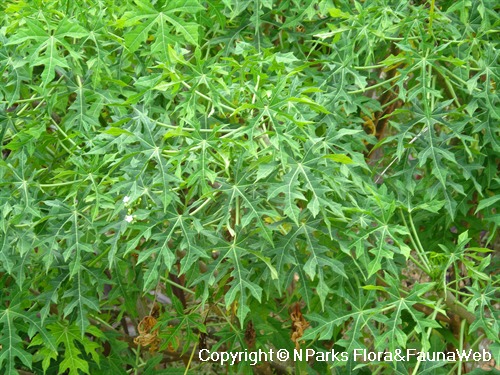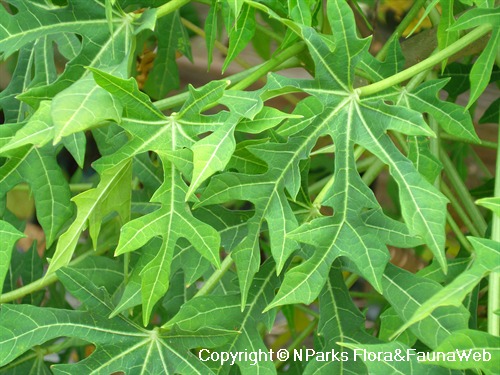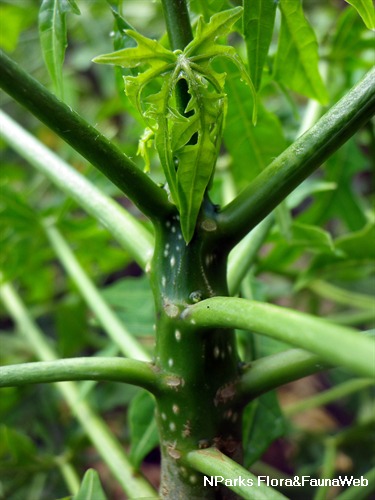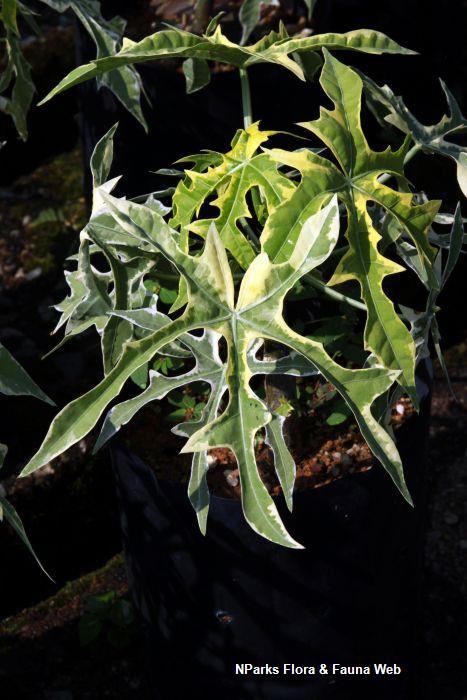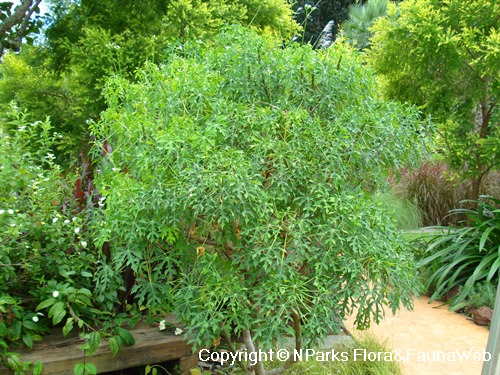
Back
Cnidoscolus chayamansa McVaugh
| Family Name: | Euphorbiaceae |
| Synonyms: | Jatropha aconitifolia var. palmata, Jatropha aconitifolia var. papaya, Cnidoscolus aconitifolius subsp. aconitifolius |
| Common Name: | Mayan Spinach Tree, Chaya |
Name
Classifications and Characteristics
| Plant Growth Form | Shrub |
|---|---|
| Mode of Nutrition | Autotrophic |
Biogeography
| Native Distribution | Central America |
|---|---|
| Native Habitat | Terrestrial |
| Preferred Climate Zone | Tropical |
Description and Ethnobotany
| Growth Form | Shrub to small tree, able to grow up to about 3 m tall. |
|---|---|
| Foliage | Leaves green, palmately 3 - 5 lobed, measuring up to 15 cm long. |
| Flowers | This species bears separate male and female flowers, but on the same long peduncled cyme inflorescence. Flowers white, about 1 cm wide. |
| Fruit | Fruit is a seed pod. |
| Etymology | Genus Cnidosculos is from the Greek words "knide" and "skolos" which means "nettle" and "thorn", and refers to the stinging hairs on the plant. Species chayamansa is from the Mayan word "chaay" which means "plant" and the Latin word "mansa" which means house. |
| Ethnobotanical Uses | Edible Plant Parts : Edible Leaves, Edible Stems Food (Fruit or Vegetable): Younger leaves and stems can be eaten, but they must be cooked thoroughly before consumption. Raw leaves and stems are poisonous and cannot be eaten. |
Landscaping Features
| Desirable Plant Features | Ornamental Foliage |
|---|---|
| Landscape Uses | General, Parks & Gardens, Small Gardens |
| Usage Hazard - Cons | Irritant - Sap |
| Usage Hazard - Cons Remarks | Stinging hairs are present on the young parts of the stem. Avoid handling the plant unless using gloves. Produces a white sap when injured or cut. Avoid getting into contact with the sap as it may cause allergies. |
Fauna, Pollination and Dispersal
| Pollination Method(s) | Biotic (Fauna) |
|---|
Plant Care and Propagation
| Light Preference | Full Sun |
|---|---|
| Water Preference | Moderate Water |
| Rootzone Tolerance | Well-Drained Soils |
| Pest(s) | Sucking Insects |
| Propagation Method | Stem Cutting |
Foliar
| Mature Foliage Colour(s) | Green |
|---|
Floral (Angiosperm)
| Flower Colour(s) | White |
|---|---|
| Flower Grouping | Cluster / Inflorescence |
Image Repository
Others
| Master ID | 30530 |
|---|---|
| Species ID | 4839 |
| Flora Disclaimer | The information in this website has been compiled from reliable sources, such as reference works on medicinal plants. It is not a substitute for medical advice or treatment and NParks does not purport to provide any medical advice. Readers should always consult his/her physician before using or consuming a plant for medicinal purposes. |

